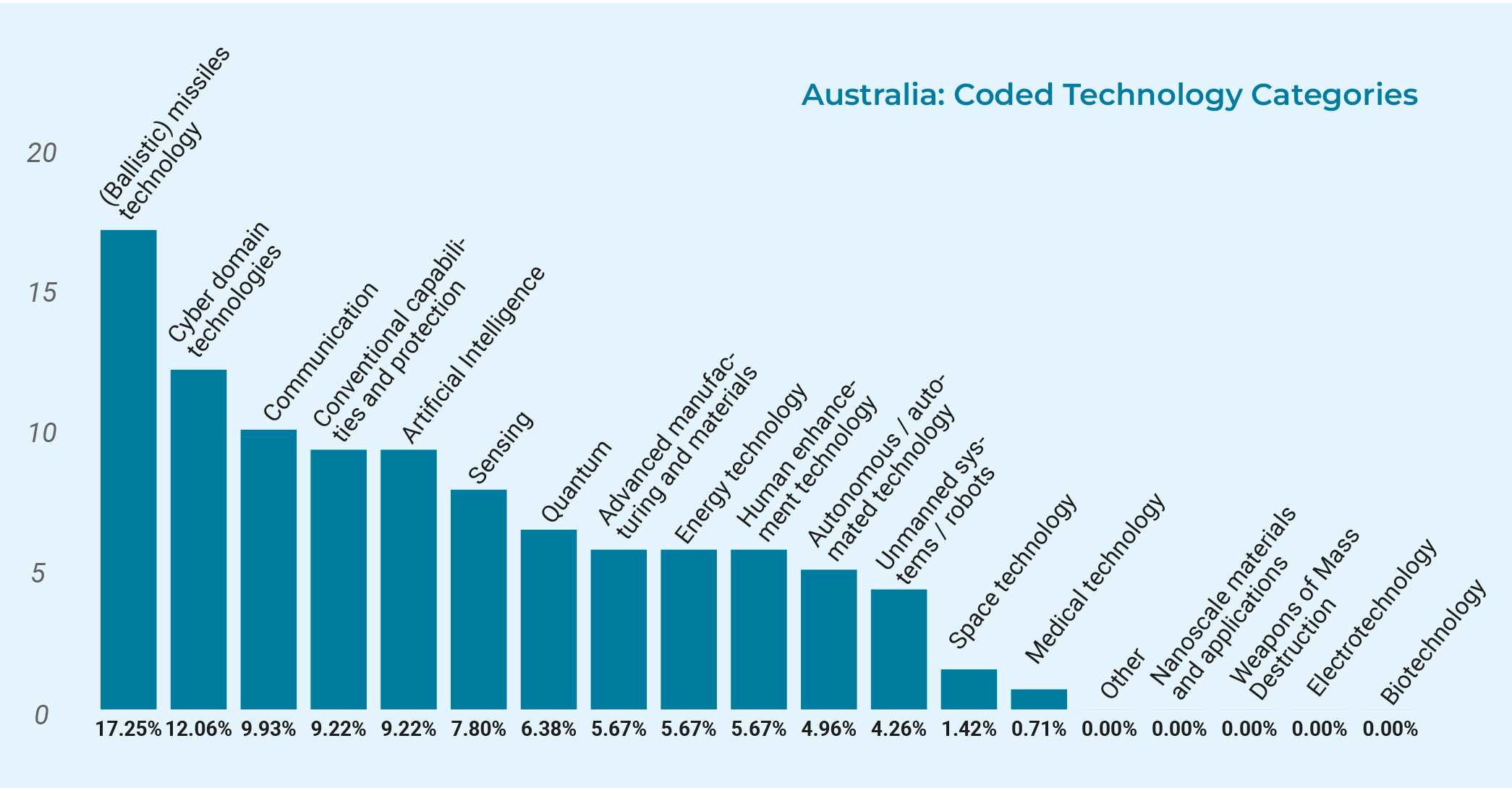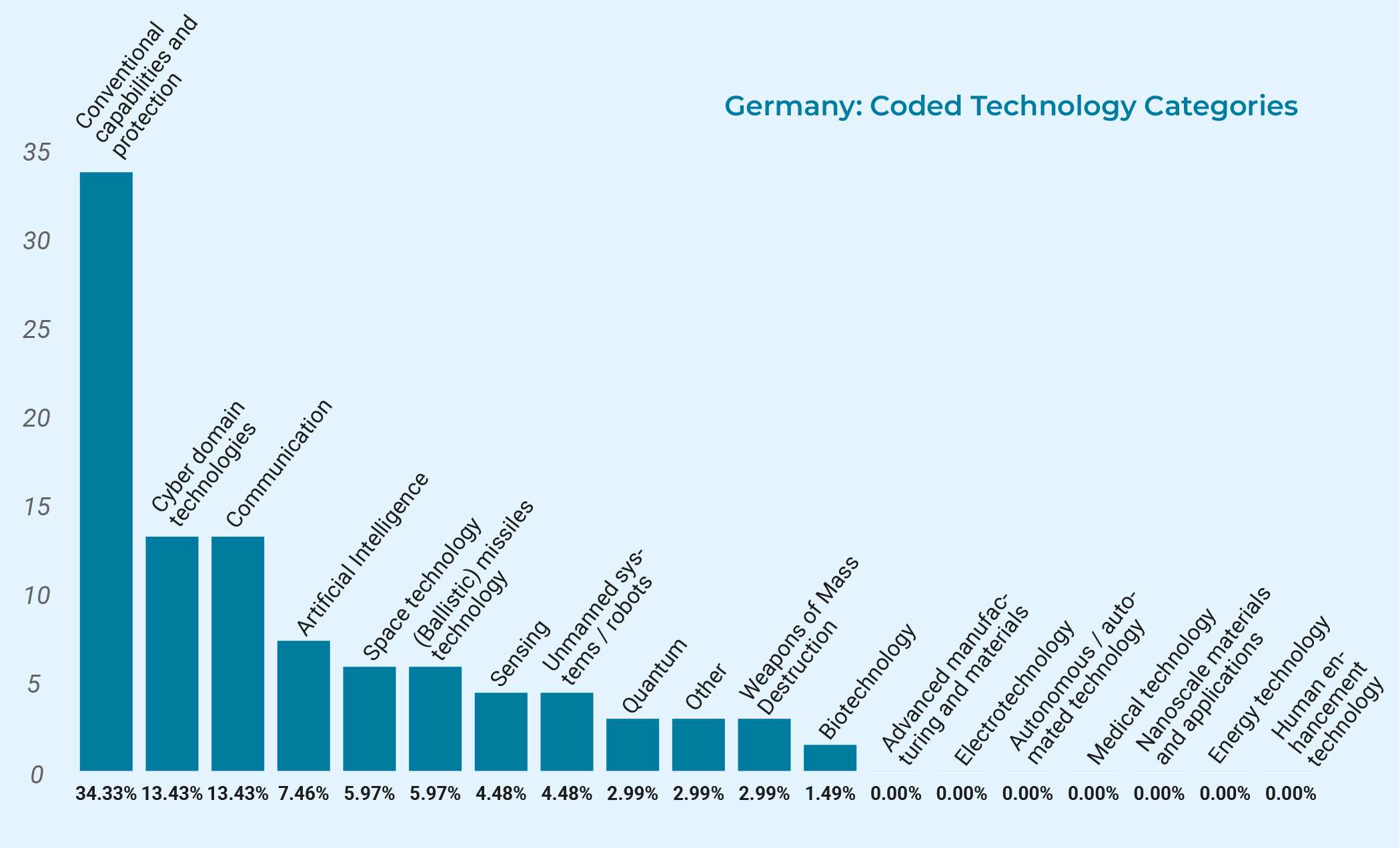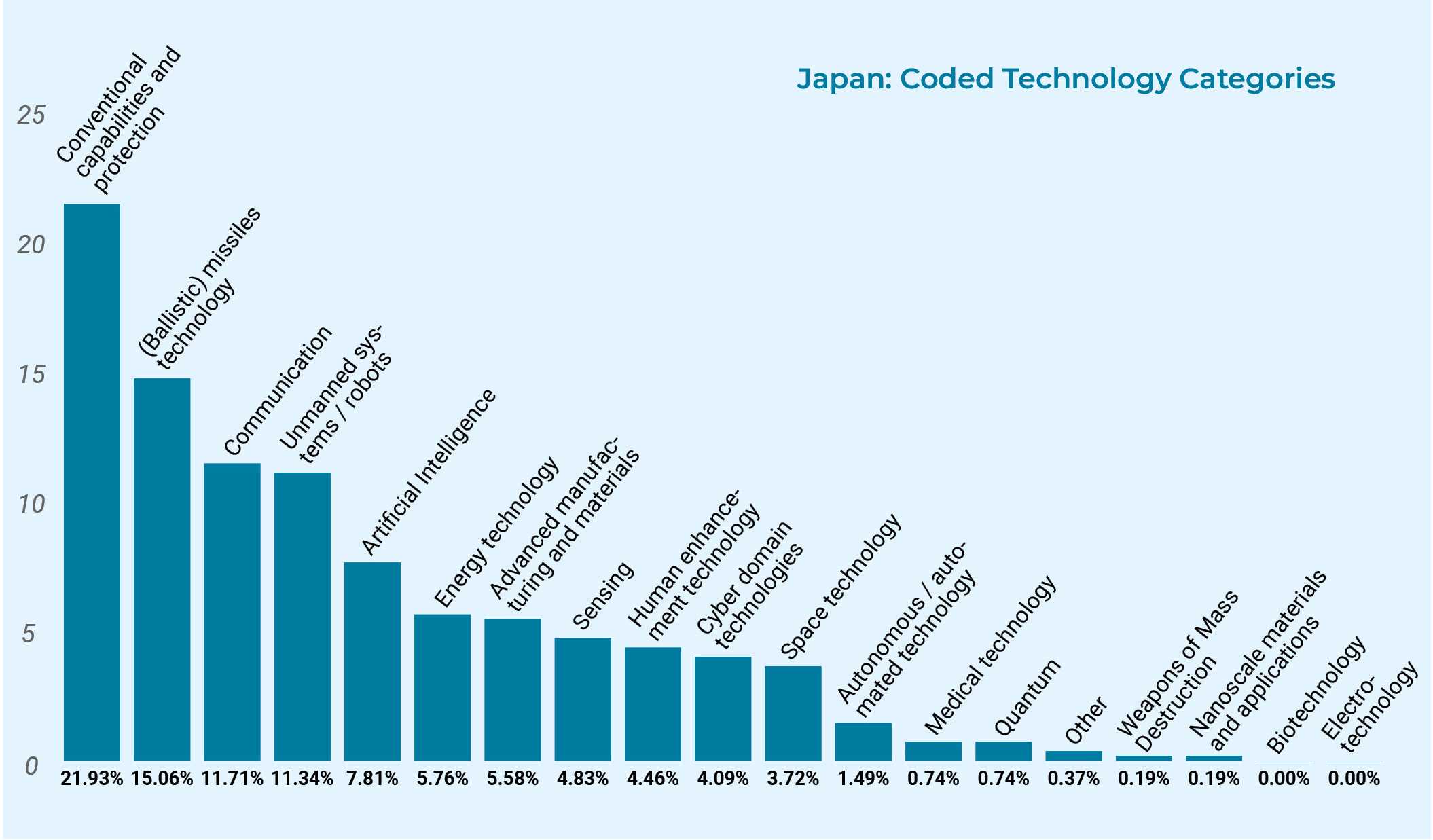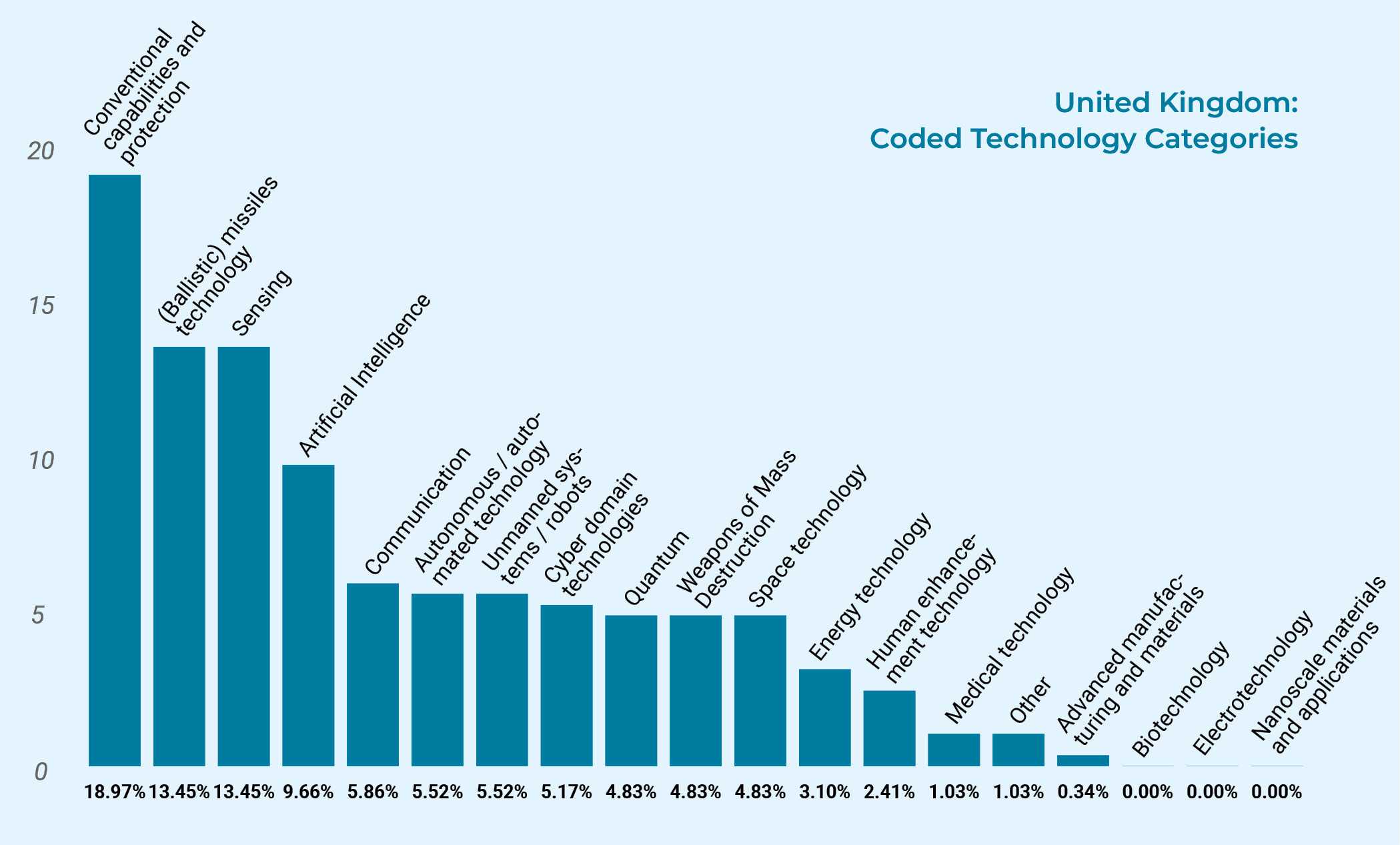Technology Preferences of Five Western Style Democracies: An Analysis of Security Policy Technology Strategies
The character of warfare is continuously and rapidly evolving. This chapter explores military technologies that may come to dominate future battlefields. Will the war against Ukraine become the future benchmark for military technology, or are countries already thinking ahead? By analyzing the two latest military technology strategies of five democracies, with a particular focus on military technologies individually and in the aggregate, the study shows that, in addition to communications and AI, upgraded “legacy” systems like tanks, combat aircraft, and maritime assets remain crucial. However, significant emphasis is also placed on advanced missile technology, AI, and reconnaissance. While the destabilizing potential of autonomous weapons and military AI has been the subject of worldwide debate for some time, the destabilizing effect of conventional missiles has so far received little international attention. This issue calls for intensified discussion, focusing on guidelines, effective defensive measures, and arms control.
Military technology is currently developing at a tremendous rate. While rapid developments in artificial intelligence taking place in the civilian sector are one reason for this acceleration, another is the changing international security landscape. Among the many drivers of change, Russia’s war of aggression against Ukraine has been the most significant factor pushing drone technology far ahead of what was available three years ago. Nevertheless, military technology choices remain national decisions based on perceived threats, individual technological capabilities, and the desire to retain advantage – or at least not to fall behind – in certain areas. In addition, prestige, ethical attitudes, and legal interpretations also play an important role. This chapter presents the military technology preferences of five selected countries – Australia, Germany, the United Kingdom, Japan, and the USA – based on each nation’s two most recent national technology strategy documents. Explicit reference is made to the security sectors that do not focus on a particular military service or technology field. The preferences of each nation illustrate a vision for future capabilities, rather than definitive procurement plans. Strategies and technologies are not static, and technological research and development does not automatically lead to the adoption of military innovation. The papers therefore describe expressions of interest and not necessarily concrete actions. However, technology strategies still afford an insight into the technologies currently perceived as relevant for future combat. They also offer a glimpse into the battlefield of the future, while serving as an indicator of potential dangers and their possible solutions.
The analysis is based on a qualitative content analysis of two papers from five countries, each published during the past five years.1 Although the papers were written at different times, both before and after the start of the war against Ukraine, the overall picture is compelling and coherent. The coding of our content analysis was focused on technologies in which a country has shown interest, is already investing, or plans to invest. Our coding scheme comprises 20 main categories (e.g. AI or Communications) and a total of 135 subcategories. To keep this text concise, we focus primarily on the main categories and occasionally add specific references to subcategories.
In the following section, we present the results for each of the five countries individually, before taking a comparative perspective.
Individual Country Summaries
Australia
The Australian analysis covers two National Security Science and Technology Papers from 2020 and 2024.2 Australia has always seen itself as the ‘odd man out’ in Asia and has developed a perception of threat and security that has always aligned closely with its strong Western allies – until 1942 with Great Britain, and thereafter with the United States. Given its rapid technological innovation paired with a sense of insecurity, Australia feels that new military technologies increase the country’s vulnerability. In consequence, the analysis of technological developments and the question of how to counter those developments with own investment is a big issue in Australia. Technologies of most interest to Australia include the latest aeronautics and missile technology, defensive and offensive cyber capabilities, communications technology, AI, and sensing technology.
Strategically, Australia’s focus is understandable. Given the immense maritime area that Australia must monitor, improved or new forms of reconnaissance equipped with the latest sensors, networked communication, and AI-based analysis offer the opportunity to quickly identify potential threats (e.g. from China) and concentrate assets accordingly. Precise conventional missiles can help to engage high-value targets at greater distances without relying on support from partners. This impression is reinforced by the fact that both ballistic missile technology and hypersonic missiles are considered particularly relevant technologies. A strong focus on cyber, AI, and quantum technology rounds off the picture of a nation aiming to counter a perceived threat through the military use of cutting-edge technologies.

Germany
A comparison of Germany’s security and defense industry strategy papers from 2020 and 2024 reveals a clear shift in the understanding, definition and prioritization of new technologies. The 2020 ‘Strategy Paper on Strengthening the Security and Defence Industry’ focuses on identifying “key national technologies” and views technological progress primarily as an industrial competitive advantage.3 The broader fields of technology are focused on conventional military capabilities and protection as well as cyber measures, AI, electronic warfare, and sensor technology. These are to be strengthened through measures of research and development, production, procurement, and export regulation, and in some cases expanded at the European level through cooperation.
The follow-up 2024 ‘National Security and Defence Industry Strategy’, is a visible response to the changed geopolitical conditions, such as the need for stronger and more sustainable military protection and the vulnerability to coercion due to global technological dependencies.4 Although the scope of key national technologies remains mostly unchanged – with the addition of quantum technology and space technology – the strategy focuses more strongly on individual technologies and discusses their significance. This applies particularly to IT products, software, and the need for comprehensive cybersecurity. The updated strategy does not shift priorities but instead emphasizes the need for the greatest possible sovereignty in these areas. It further highlights economic and technological dependencies as a problem, and stresses measures such as the protection of critical supply chains and close coordination with EU and NATO partners.
Overall, there is a shift from an economic and industrial perspective to a strategic concept of technology that focuses on resilience, digital security and international cooperation – a significantly broader understanding of ‘new technologies’ and their relevance to security policy.

Japan
In its technology and “build-up” strategies, published in 2022 and 2023, Japan links national security and defense with vital advancements in science and technology.5 Therefore, it is essential for Japan to “promote harmony”6 and thus cooperate more effective between various strategies and technologies for security and defense. To that end, the focus lies on conventional capabilities, (ballistic) missiles technology, and communication technologies. In this context, conventional capabilities include technologies for rotary- and fixed wing aircraft together with vehicle systems for land, sea- and subsurface, while missiles technology covers (ballistic) missiles, and air defense technologies, and hypersonic missiles. Electronic warfare and command and control systems make up the core of the communication technologies in the strategies. Other important pillars for Japan are unmanned systems and robotics, in which UAVs (unmanned aerial vehicles) are highly favored. Artificial intelligence-based technologies – notably AI for data science – are intended to advance the development of conventional capabilities. Additionally, interest in enhancing “warfighters’ cognitive capabilities”7 and improvements in human performance are also substantial. Although the air domain receives particular attention, the strategies still try to imply a holistic view in which the interplay of new technologies and conventional capabilities is crucial for Japan to “reinforce its ‘Multi-Domain Defense Force’”.8 This is understandable given Japan’s geopolitical position as an island nation located near China, Russia, and North Korea, as well as its strategic ambitions in the Indo-Pacific region alongside allies like the United States and Australia.9

United Kingdom
For this article the United Kingdom’s (UK) Science and Technology Strategy 2020 and the Defence Capability Framework 2022 were analyzed. They position the UK in broad and general competition with adversaries and emphasize the crucial role of emerging technologies in winning such competition. While China, Russia, and adversarial actors in the cyber domain are explicitly mentioned, confrontational scenarios or theatres are not specified. However, it is stressed throughout the strategies that emerging technologies are crucial for preparing for the future, as they “can give the UK a decisive edge in the future”.11 Overall, the strategies are characterized by a reactive sentiment in a realm that describes S&T as “strategic theatre of competition”,12 in which the UK must accelerate innovation and development (“we must up our game”)13 to keep pace with the rapid – yet undefined – adoption of technology by adversaries. Considering the focus on emerging technologies and their importance for future warfighting capabilities, it is surprising that nearly a quarter of all annotations of the strategies concern advanced aeronautical and missile technologies, especially aircraft (11.38%, coded asconventional capabilities). This shows that, although modernization and capability challenges are significant for the UK, future battles are expected to be fought kinetically in the air domain. Therefore, emphasis is placed first on maintaining the capability to project power externally, with missile technology taking second place. This conception is complemented by sensing in third place, highlighting the importance of technology for maintaining theatre awareness. With AI-enabled and autonomous applications ranking fourth and fifth in all subcategories, the UK strategies position these technologies as enablers for “consequential and significant changes to our force structure”14 – though without specifying details.

United States of America
In the National Defense Science and Technology Strategy (S&T) 2023, the United States presents itself as robust and assured in its military technical capability.15 The S&T strategy outlines measures for an environment that aims to ensure its “global leadership”, maintaining the U.S.’s “competitive edge in defense science and technology”.16 Those efforts emphasize the importance of collaborating with allies and partners for innovation, as well as protecting knowledge and intellectual property, and other aspects of military innovation such as prototyping and fielding. Technologies themselves are less frequently mentioned in the strategy, as they are listed without much description or contextualization in a separate list: the Critical and Emerging Technologies List Update 2022.17 This list has also been part of our analysis, in which the U.S. lays out some specific technologies that are necessary to “maintain shared technological advantages”18 with allies. Unlike other states, there is no clear technological preference in the numbers. While the U.S. has designated S&T strategies for each branch of its military detailing their technological priorities, the overall S&T strategy and corresponding lists do not extensively address kinetic armament. Instead, they focus on high-level priorities such as research in communication technology, advanced manufacturing and materials, sensing, AI technology, and energy technology. The subcategories reflect those numbers, with no clear preference discernible, although unspecified sensing and materials are most often coded as a single subcategory. Overall, the U.S. strategies are less specifically focused on research for specific applications in these strategies but rather encourage research across the board with a preference for non-kinetic technologies, e.g. digital technologies and applications.

The Macro Perspective
Looking at the top-ten, top-level categories in each country, a clear picture emerges:
The clear top priority for the status under scrutiny is to develop advanced communications technology. As the war in Ukraine has shown, stable communication lines are key when coordinating troops or steering drones. The category also includes – according to our coding scheme – command and control systems (Cx), network technologies or electronic warfare systems capable of denying or deceiving adversary sensors. The second most important category is classical conventional capabilities and protection, including classical weapon systems like tanks, ships, airplanes, new types of ammunition, improved armor, or stealth capabilities. In Germany, Japan and the UK this category even ranks 1st. This shows that so-called “legacy systems” still do play a major role in future military planning – yet in newer and more high-performing variations. The next technological category upon which the five states agree is AI, with data science being the most important concrete subcategory. While most countries are rather specific about the use of AI in their militaries (e.g. data science, high performance computing, etc.), others, like Germany, only mention AI in a generic way, without spelling out any particular use cases.

In place four we found missile technology. This technology has the highest priority in Australia and features prominently in 2nd place in Japan and the UK. Over the past decade, rocket propulsion technology has spread worldwide. Even civilian companies are now manufacturing rockets that only a decade ago were reserved for wealthy countries. Today, many more countries are capable of producing at least simple rocket systems, which they can use to threaten important military hubs or key military targets of their adversaries – a reason they are colloquially referred to as ‘the poor man’s air force’. The great danger of missile proliferation – and its core destabilizing characteristic – lies in the very short windows of warning afforded by fast-flying missiles and the limited (and often very expensive) options for intercepting them. It is conceivable that the category ‘missiles’ is under-represented in our coding because certain propulsion systems are coded under ‘space’. This will be examined in more detail in further publications.
The fifth category is “sensing”. Again, while some countries, in this case the U.S., often mention sensing in a generic way, others, like Australia, give more detailed explanations as to the kinds of sensors they want to develop (e.g. atomic clocks, sensor networks, or sensors to detect CBRN agents).
Taking these findings together, a clear picture emerges: Western states want to keep or even improve their advantage in battlefield awareness and pair this with higher precision engagement. Having increasingly potent sensors increases the need for both communication lines, devices capable of dealing with immense amounts of data, and AI that can help turn this into actionable information. Identifying and locating potential threats as early as possible and lifting the ‘fog of’ war for precision strikes is a priority Western states seem to share.
However, an interesting yet puzzling observation is that although unmanned systems dominate public debate on new procurement programs and counter UAV systems, they only occupy place eight in the top ten – with the exception of Japan, where they are in third place.
Conclusion
When Western countries discuss the future role of cutting-edge technology in their military, they do not only look at technologies that are traditionally regarded as ‘emerging’ and ‘disruptive,’ but aim for a mixture of familiar and proven concepts (albeit in significantly improved form) that are complemented or enhanced by new technologies. While small and economically less powerful countries may be inclined to focus on hoped-for disruptions, countries that can afford to do so are hedging their bets. From a stability perspective, the high importance of missiles seems worrisome. While military AI has been on the international agenda for years and – at least in the case of autonomous AI weapons – the nucleus of an international norm for their use has been developed (keyword: meaningful human control), the destabilizing effects of conventional missiles have hardly been discussed internationally, let alone addressed with any arms control instruments. The discussion on this topic must be intensified – on the one hand with regard to international guidelines, but on the other hand with regard to effective protection and future arms control.
However, to engage in international discussions, each country must address its own preferences. The data suggests that Germany is lagging behind in the public debate on how the latest military technologies can and should be used. This brings back memories of the German drone debate, in which the Federal Ministry of Defense also failed to communicate its position. It is obvious that the debate surrounding the vague term ‘Zeitenwende’ must be intensified to gain a clearer understanding of the military advantages of new technologies, as well as the potential risks to stability and opportunities for future arms control.
- For more information on the relevant categories, the full coding scheme and more information on the methodology used, see https://www.cntrarmscontrol.org/technology ↩
- Australian Government. (2020). More, together. Defence Science and Technology Strategy 2030. Department of Defence. https://apps.dtic.mil/sti/trecms/pdf/AD1155241.pdf.; Australian Government. (2024). Defence Innovation, Science and Technology Strategy. Department of Defence. https://www.defence.gov.au/sites/default/files/2025-03/Defence-IST-Strategy-2024-PRO2.pdf ↩
- Die Bundesregierung. (2020). Strategiepapier der Bundesregierung zur Stärkung der Sicherheits- und Verteidigungsindustrie. Bundeswirtschaftsministerium für Wirtschaft und Energie. https://www.bundeswirtschaftsministerium.de/Redaktion/DE/Downloads/S-T/strategiepapier-staerkung-sicherits-und-verteidigungsindustrie.pdf?__blob=publicationFile&v=4 ↩
- Die Bundesregierung. (2024). Nationale Sicherheits- und Verteidigungsindustriestrategie. Bundesministerium der Verteidgung, & Bundesministerium für Wirtschaft und Klimaschutz. https://www.bmvg.de/resource/blob/5865332/d4d0d9ab55edde72a11cee2a3ca59d3b/nationale-sicherheits-und-verteidigungsindustriestrategie-data.pdf ↩
- Government of Japan. (2022). Defense Buildup Program. Ministry of Defense. https://www.mofa.go.jp/files/100590830.pdf; Government of Japan. (2023). Defense Technology Guideline 2023. Ministry of Defense. https://www.mod.go.jp/atla/guideline2023/assets/pdf/technology_guideline2023.pdf ↩
- Government of Japan (2023). ↩
- Government of Japan (2023). ↩
- Government of Japan (2022). ↩
- Government of Japan (2022) ↩
- Government of the United Kingdom. (2020). Science and Technology Strategy 2020. Ministry of Defence. https://assets.publishing.service.gov.uk/media/5f8dc7ece90e0727ca313eb6/20201019-MOD_ST_Strategy_2020_v1-23.pdf; Government of the United Kingdom. (2022). Defence Capability Framework. Ministry of Defence https://assets.publishing.service.gov.uk/media/62d7d1668fa8f50c0a8a4029/MOD_Defence_Capability_Framework_Accessible_Jul22.pdf ↩
- Government of the United Kingdom (2020). ↩
- Government of the United Kingdom (2020). ↩
- Government of the United Kingdom (2022) ↩
- Government of the United Kingdom (2022). ↩
- United States of America. (2023). National Science and Technology Strategy. U.S. Department of Defense. https://media.defense.gov/2023/May/09/2003218877/-1/-1/0/NDSTS-FINAL-WEB-VERSION.PDF ↩
- United States of America (2023). ↩
- United States of America. (2022). Critical and Emerging Technologies List Update. U.S. National Science and Technology Council. https://bidenwhitehouse.archives.gov/wp-content/uploads/2022/02/02-2022-Critical-and-Emerging-TechnologiesList-Update.pdf ↩
- United States of America (2022). ↩